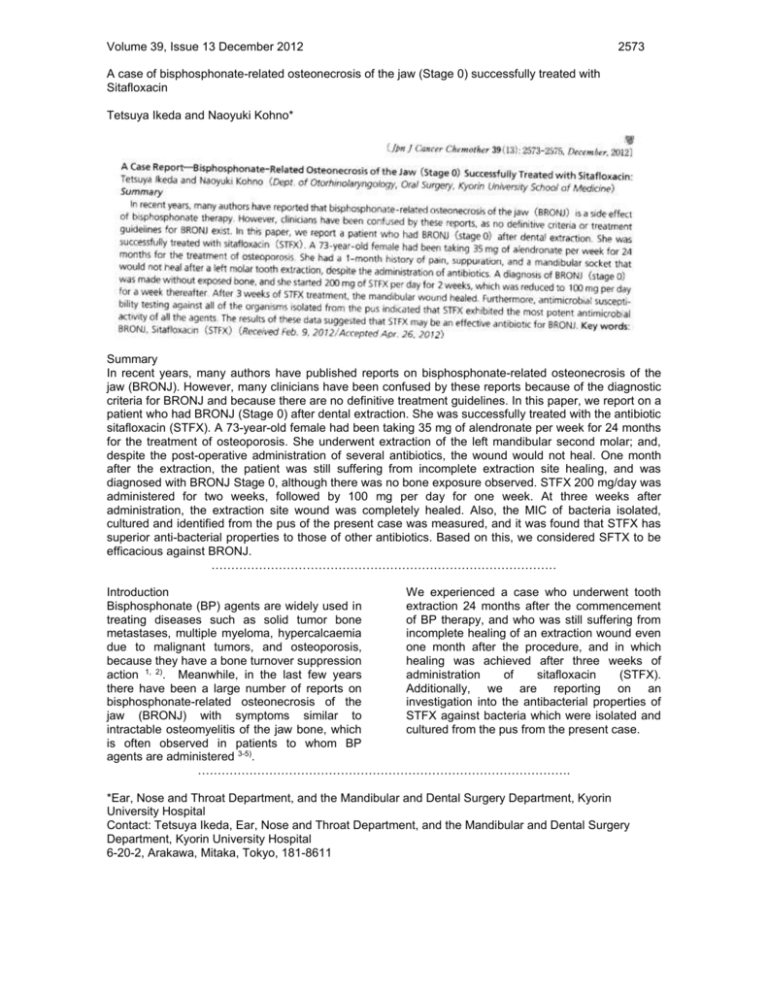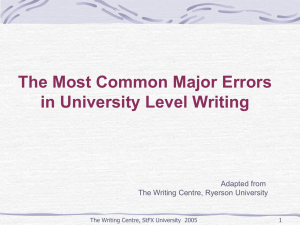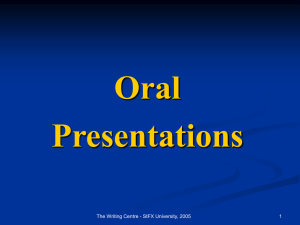Volume 39, Issue 13 December 2012 2573 A case of
advertisement

Volume 39, Issue 13 December 2012 2573 A case of bisphosphonate-related osteonecrosis of the jaw (Stage 0) successfully treated with Sitafloxacin Tetsuya Ikeda and Naoyuki Kohno* Summary In recent years, many authors have published reports on bisphosphonate-related osteonecrosis of the jaw (BRONJ). However, many clinicians have been confused by these reports because of the diagnostic criteria for BRONJ and because there are no definitive treatment guidelines. In this paper, we report on a patient who had BRONJ (Stage 0) after dental extraction. She was successfully treated with the antibiotic sitafloxacin (STFX). A 73-year-old female had been taking 35 mg of alendronate per week for 24 months for the treatment of osteoporosis. She underwent extraction of the left mandibular second molar; and, despite the post-operative administration of several antibiotics, the wound would not heal. One month after the extraction, the patient was still suffering from incomplete extraction site healing, and was diagnosed with BRONJ Stage 0, although there was no bone exposure observed. STFX 200 mg/day was administered for two weeks, followed by 100 mg per day for one week. At three weeks after administration, the extraction site wound was completely healed. Also, the MIC of bacteria isolated, cultured and identified from the pus of the present case was measured, and it was found that STFX has superior anti-bacterial properties to those of other antibiotics. Based on this, we considered SFTX to be efficacious against BRONJ. …………………………………………………………………………… Introduction We experienced a case who underwent tooth Bisphosphonate (BP) agents are widely used in extraction 24 months after the commencement treating diseases such as solid tumor bone of BP therapy, and who was still suffering from metastases, multiple myeloma, hypercalcaemia incomplete healing of an extraction wound even due to malignant tumors, and osteoporosis, one month after the procedure, and in which because they have a bone turnover suppression healing was achieved after three weeks of action 1, 2). Meanwhile, in the last few years administration of sitafloxacin (STFX). there have been a large number of reports on Additionally, we are reporting on an bisphosphonate-related osteonecrosis of the investigation into the antibacterial properties of jaw (BRONJ) with symptoms similar to STFX against bacteria which were isolated and intractable osteomyelitis of the jaw bone, which cultured from the pus from the present case. is often observed in patients to whom BP agents are administered 3-5). …………………………………………………………………………………. *Ear, Nose and Throat Department, and the Mandibular and Dental Surgery Department, Kyorin University Hospital Contact: Tetsuya Ikeda, Ear, Nose and Throat Department, and the Mandibular and Dental Surgery Department, Kyorin University Hospital 6-20-2, Arakawa, Mitaka, Tokyo, 181-8611 2574 Cancer and Chemotherapy I. Case A 73-year-old female Past history: Administered alendronate for 24 months by a nearby orthopedic surgery specialist for osteoporosis Current history: On a pre-treatment x-ray (Fig. 1a), an image of resorption in the periphery of the tooth root of the left mandibular second molar was found. Following diagnosis of the patient with periodontitis, the patient underwent extraction of the above-mentioned tooth, followed by one-week administration of cefditoren pivoxil (CDTR-PI), and minocycline (MINO) for approximately 5 days. Discharge from the extraction wound site and pain continued even four weeks from the time of extraction (Fig. 2a); therefore, the patient was diagnosed with BRONJ Stage 0, and 200 mg per day of STFX was administered for 2 weeks (Fig. 2b), followed by one week at 100 mg, after which the wound was observed to be healed with no bone exposure (Fig. 1b and 2c.) STFX is a new quinolone group oral antibiotic which is indicated for infectious diseases in the fields of pulmonary medicine, otolaryngology, and dentistry and stomatology. Also, this drug has strong antibacterial properties against intra-oral Streptococcus and intra-oral anaerobic bacteria (6) and this drug also has high permeability through gum tissue (7) . Since STFX was highly efficacious against BRONJ in the present case, we measured the minimum inhibitory concentration (MIC) against bacteria which were isolated and cultured from the present case. We followed reports from Murray et al (8) in carrying out the identification assay on bacterial sample from the pus from the disease site. Moreover, we followed the Clinical and Laboratory Standards Institute (CLSI) method in measuring the MIC of various antibiotics against bacteria isolated from the pus. In other words we employed a micro-volume liquid dilution method for aerobic bacteria and an agar plate dilution method for anaerobic bacteria. We used the following 10 antibiotics: STFX, levofloxacin, azithromycin, clarithromycin, amoxicillin, cefcapene, cefdinir, meropenem, minocycline and clindamycin. The results identified a total of 5 bacteria types, namely 2 types of aerobic bacteria (Streptococcus anginosus and Streptococcus constellatus) and 3 types of anaerobic bacteria (Prevotella buccae, Fusobacterium nucleatum and Porphyromonas asaccharolytica) (Table 1). The MIC of STFX against these isolated bacteria was from 0.015µg/ml to 0.06µg/ml, and STFX showed the highest antibacterial properties compared to other antibiotics. II. Discussion In recent years, there have been a large number of reports on BRONJ in Japan, and the position paper issued by the BP related jaw bone necrosis investigation committee (9) has certain guidelines for the evaluation and treatment policies of BRONJ. However, since patients will not be diagnosed with BROJ unless 8 weeks of jaw bone exposure is observed, there is a possibility that there will be delay in response leading to late treatment. Based on this, our department considers that the Stage 0 is an important disease period, and we determine that a patient is in BRONJ Stage 0 if a BP agent was administered to the patient even for a short period and if incomplete healing of the gum wound is observed, and we administer STFX to such patients. As it is clearly seen in the present investigation, STFX is observed to have highly favorable antibacterial properties against BONJ (Table 1). Also, STFX is considered to be a drug which has high permeability through jaw bone tissue; therefore STFX is an antibiotic of the last resort if other antibiotics are not efficacious. Hosaka et al. reported that the MIC of STFX against periodontal disease-related bacteria was 0.25µg/ml (6). Since the present investigation found that BRONJ pathogenic bacteria have the same qualities as those of periodontal disease-related bacteria, we consider that the results showed superior antibacterial properties of STFX in the same way as in the report by Hosaka et al. We anticipated that STFX is particularly and remarkably efficacious in the clinic for patients at Stage 0 with whom bone exposure is not observed, such as in the present case. Additionally, the patient in the present case suffered from osteoporosis, and we anticipate that STFX is also efficacious against BRONJ due to injectable BP agents administered to patients suffering from malignant tumors. References 1) Berenson JR, Lichtnstein A, Porter L, et al: Efficacy of pamidronate in reducing skeletal events in patients with advanced multiple Myeloma Aredia Study Group. N Engl J Med 334(8): 488-493, 1996. 2) Hortobagyi GN, Theriault RL, Porter L, et al: Efficacy of pamidronate in reducing skeletal complications in patients with breast cancer and lytic bone metastases. Protocol 19 Aredia Breast Cancer Study Group. N Engl J Med 335(24): 1785-1791, 1996. 3) Wang J. Goodger NM, Pogrel MA, et al: Osteonecrosis of the jaws associated with cancer chemotherapy, J. Oral Maxillofac Surg 61(9): 1104-1107, 2003. 4) Marx RE: Pamidronate (Aredia) and zoledronate (Zometa) induced avascular necrosis of the jaws: a growing epidemic. J. Oral Maxillofac Surg 61(9): 1115-1117, 2003. 5) Ruggiero SL, Mehrotra B, Rosenberg TJ, et al: Osteonecrosis of the jaws associated with the use of bisphosphonates: a review of 63 cases, J. Oral Maxillofac Surg 62(5): 527-534, 2004. 6) Yasuo Hosaka, Jyun Saito, Kazuyuki Ishihara et al: The antibacterial propertyiesof sitafloxacin against periodontitisrelated bacteria, Journal of periodontal research. 52(3): 239-244, 2010. 7) Jiro Sasaki, Seiji Hori. The efficacy, safety and permeation through oral cavity tissue of sitafloxacin in treating infectious diseases in the field dental and oral surgery; Journal of infection and chemotherapy; 56(S-1): 121-129, 2008. 8) Murray PR, Baron EJ, Jorgensen JH, et al: Manual of Clinical Microbiology, 9th edition, American Society for Microbiology, 2007. 9) Yoneda T, Hagino H, Sugimoto T, et al: Bisphosphonate related osteonecrosis of the jaw: position from the Allied Task Force Committee of Japanese Society for Bone and Mineral Research, Japan Osteoporosis Society, Japanese Society of Periodontology, Japanese Society for Oral and Maxillofacial Radiology, and Japanese Society for Oral and Maxillofacial Surgeons. J Bone Miner Metab 28(4): 365-383, 2010.











